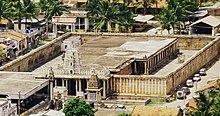Bhandara Basadi
This article includes a list of general references, but it lacks sufficient corresponding inline citations. (May 2022) |
| Bhandara Basadi | |
|---|---|
ಭಂಡಾರ ಬಸದಿ | |
 Bhandara Basadi | |
| Religion | |
| Affiliation | Jainism |
| Deity | Tirthankara |
| Festivals | Mahavir Jayanti |
| Location | |
| Location | Shravana Belgola, Hassan, Karnataka |
| Geographic coordinates | 12°51′24.1″N 76°29′19.4″E / 12.856694°N 76.488722°E |
| Architecture | |
| Style | Hoysala architecture |
| Creator | Hula Raja |
| Date established | 1159 CE |
Bhandara Basadi or Chaturvimsati Tirthankar Basadi is a Jain temple (basadi) built in located in Shravanabelagola, a town in Karnataka, India.
History[edit]
The temple was constructed in 1159 CE by Hula Raja, a general and bhandari (transl. treasurer) during the reign of King Narasimha I of Hoysala Empire, giving temple the name Bhandara Basadi. According to inscription, dating back to 1159 CE, inside the temple gave grants for the temple and gave the name Bhavya-Chamundi temple.[1][2][3] One inscription inside the temple records a major dispute between Vaishnav and Jain and its resolution by King Bukka of Vijayanagara Empire.[4][5]
Architecture[edit]

Bhandara Basadi is the largest temple in Shravanabelagola measuring 266 by 76 feet (81 by 23 m). The temple is dedicated to 24 Tirthankaras and is hence also known as Chaturvimsati Tirthankar Basadi. The garbhagriha houses 3 feet (0.91 m) idols of 24 Tirthankaras in kayotsarga posture with a ornate pedestal.[6][7][2] There are idols of Padmavati and Brahmdev outside the garbhagriha.[8] The central part of navaranga (hall) floor contains a 10 feet (3.0 m) monolithic slab which popular in Hoysala architecture.[3][9]
The temple also includes a monolithic manasthamba with chaturmukha idol facing four cardinal direction.[8]
See also[edit]
References[edit]
Citations[edit]
- ^ Sangave 1981, pp. 18–19.
- ^ a b Raman 1994, p. 55.
- ^ a b Chugh 2016, p. 288.
- ^ Kulke & Sahu 2022, p. 71.
- ^ Chattopadhyaya 2003, p. 139.
- ^ Shah 1987, p. 126.
- ^ Knapp 2008, p. 496.
- ^ a b Sangave 1981, p. 18.
- ^ Chugh 2017, p. 310.
Sources[edit]
- Chattopadhyaya, Brajadulal (2003). Studying Early India: Archaeology, Texts, and Historical Issues. Orient Blackswan. ISBN 9788178241432.
- Chugh, Lalit (2016). Karnataka's Rich Heritage - Art and Architecture (From Prehistoric Times to the Hoysala Period ed.). Notion Press. ISBN 9789352068258.
- Chugh, Lalit (2017). Karnataka's Rich Heritage – Temple Sculptures & Dancing Apsaras: An Amalgam of Hindu Mythology, Natyasastra and Silpasastra. Chennai: Notion Press. ISBN 978-19-4713-736-3.
- Knapp, Stephen (2008). Seeing Spiritual India. iUniverse. ISBN 9780595614523.
- Kulke, Hermann; Sahu, Bhairabi Prasad (13 January 2022). The Routledge Handbook of the State in Premodern India. Taylor & Francis. ISBN 9781000485141.
- Raman, Afried (1994). Bangalore - Mysore. Bangalore: Orient Blackswan. ISBN 9780863114311.
- Sangave, Vilas Adinath (1981). The Sacred ʹSravaṇa-Beḷagoḷa: A Socio-religious Study. Murtidevī granthamālā. Vol. 8. Mumbai: Bhartiya Jnanpith. ISBN 9789326355599.
- Shah, Umakant Premanand (1987), Jaina-rūpa-maṇḍana: Jaina iconography, Abhinav Publications, ISBN 978-81-7017-208-6
External links[edit]
![]() Media related to Bhandara Basadi at Wikimedia Commons
Media related to Bhandara Basadi at Wikimedia Commons
